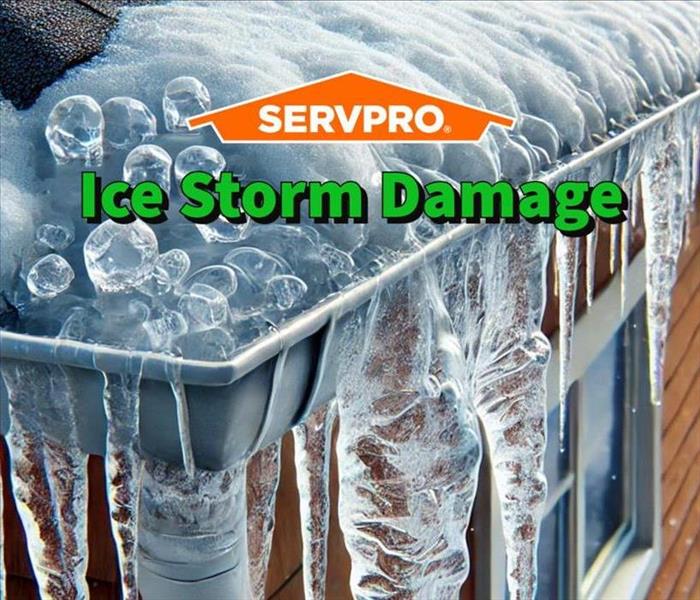Ice Storm Damage: 7 Powerful Tips to Protect Your Property
1/27/2025 (Permalink)
This expert guide on ice storm damage provides essential insights and actionable steps to safeguard your property from winter's most severe challenges.
When winter strikes with an ice storm, properties face a unique and formidable threat. Ice storm damage can have significant structural and financial consequences for homeowners and businesses. Freezing rain, heavy ice accumulation, and plummeting temperatures create hazardous conditions that may result in severe property damage.
This blog post explores the common causes of ice storm damage, offers practical prevention tips, and highlights how SERVPRO® professionals can provide expert restoration services to mitigate damage and restore properties effectively.
What are the common causes of ice storm damage?
Ice storms can wreak havoc in multiple ways, each posing unique challenges to property owners. The primary causes of ice storm damage include:
- Roof and structural stress: The accumulation of heavy ice can exert excessive weight on roofs, gutters, and supporting structures, leading to potential collapses or severe damage.
- Frozen pipes: Ice buildup around plumbing systems increases the risk of frozen and burst pipes, causing water damage throughout the property.
- Fallen trees and power lines: Ice accumulation on trees and utility lines can lead to breakage, resulting in property damage and power outages.
- Blocked gutters and drainage systems: Ice formation in gutters can prevent proper water flow, leading to water infiltration and interior damage.
- Slippery walkways and driveways: Accumulated ice creates dangerous walking conditions that can lead to accidents and liability concerns.
How can frozen pipes contribute to ice storm damage?
Frozen pipes are one of an ice storm's most common and costly consequences. When the water inside pipes freezes, it expands, increasing the internal pressure and often leading to pipe bursts. This can result in:
- Significant water leakage that damages walls, flooring, and furniture.
- Structural weakening due to prolonged water exposure.
- Potential loss of essential utilities, such as heating and plumbing.
Tips to prevent ice storm damage
While ice storm damage can be severe, proactive steps can help minimize the risk. Here are seven powerful prevention tips:
- Insulate pipes and attics: Protect exposed pipes and ensure proper insulation in attics, basements, and crawl spaces to prevent freezing.
- Trim trees and remove weak branches: Regularly maintain trees around your property to minimize the risk of ice-laden branches falling on roofs and power lines.
- Install gutter guards and heating cables: Prevent ice dams and blockages by using heating cables and guards to maintain proper water flow.
- Seal doors and windows: Reduce drafts and prevent ice formation inside by sealing all openings and cracks around windows and doors.
- Maintain consistent indoor temperatures: Keeping your home at a steady temperature, even during absences, helps prevent frozen pipes and structural stress.
- Regularly inspect your roof: Assess for any weak spots or areas prone to ice buildup and address them before winter sets in.
- Keep emergency supplies on hand: Having salt, sand, and a generator ready can help manage immediate risks during and after an ice storm.
Following these preventive measures can significantly reduce the impact of ice storms on your property.
A recent ice storm emergency in Atlanta, Georgia
In Atlanta, Georgia, SERVPRO recently responded to a commercial property's urgent ice storm emergency. The building sustained extensive damage due to a collapsed roof caused by the weight of accumulated ice. The water intrusion from burst pipes further compounded the issue, threatening critical business operations.
Upon receiving the call, SERVPRO mobilized a specialized response team to assess the damage and implement an action plan that included:
- Emergency water extraction: The team swiftly removed standing water to prevent further damage and mold growth using state-of-the-art equipment.
- Structural stabilization: Temporary support structures were installed to prevent further collapse while permanent repairs were assessed.
- Drying and dehumidification: Advanced drying equipment and dehumidifiers were deployed to restore moisture levels and preserve building materials.
- Preventive reinforcement: Additional measures were taken to enhance insulation and drainage, helping protect the property from future ice-related damage.
The swift response and expert intervention by SERVPRO restored the property and provided valuable guidance on future preventive measures.
What should you do when you experience ice storm damage?
When faced with ice storm damage, quick action is crucial. Here are the recommended immediate steps:
- Ensure personal safety: Avoid hazardous areas with fallen debris, broken structures, or ice-covered surfaces.
- Turn off water and utilities: If pipes burst, shut off the water supply and disconnect electricity to prevent further damage and potential hazards.
- Document the damage: Take photos and record details for insurance purposes.
- Contact SERVPRO: Professional restoration services are essential for thorough damage assessment, cleanup, and long-term restoration.
Wrapping up
SERVPRO stands as a trusted leader in restoring properties affected by ice storm damage. Our commitment to rapid response, advanced restoration techniques, and customer-focused solutions ensures that your property receives the highest level of care.
Choosing SERVPRO means partnering with experts dedicated to helping you weather the challenges of winter storms. Whether it's immediate restoration or preventive guidance, our team is here to support you every step of the way.
Prepare today and rest easy knowing that SERVPRO is ready to assist whenever ice storm challenges arise. If you find yourself facing ice storm damage, call SERVPRO for expert restoration services you can trust.




 24/7 Emergency Service
24/7 Emergency Service
